Key takeaways:
- Nightclub music venues create unique experiences through immersive environments, where sound and atmosphere foster emotional connections.
- Fresh sets keep audiences engaged, providing new music and experiences that enhance the venue’s identity and create anticipation for future visits.
- Collaboration with other artists and incorporating real-time audience feedback can elevate performances, fostering a deeper connection and enhancing the overall experience.
- Engaging the crowd through interactive techniques, like call-and-response and social media, cultivates a sense of community and loyalty among patrons.
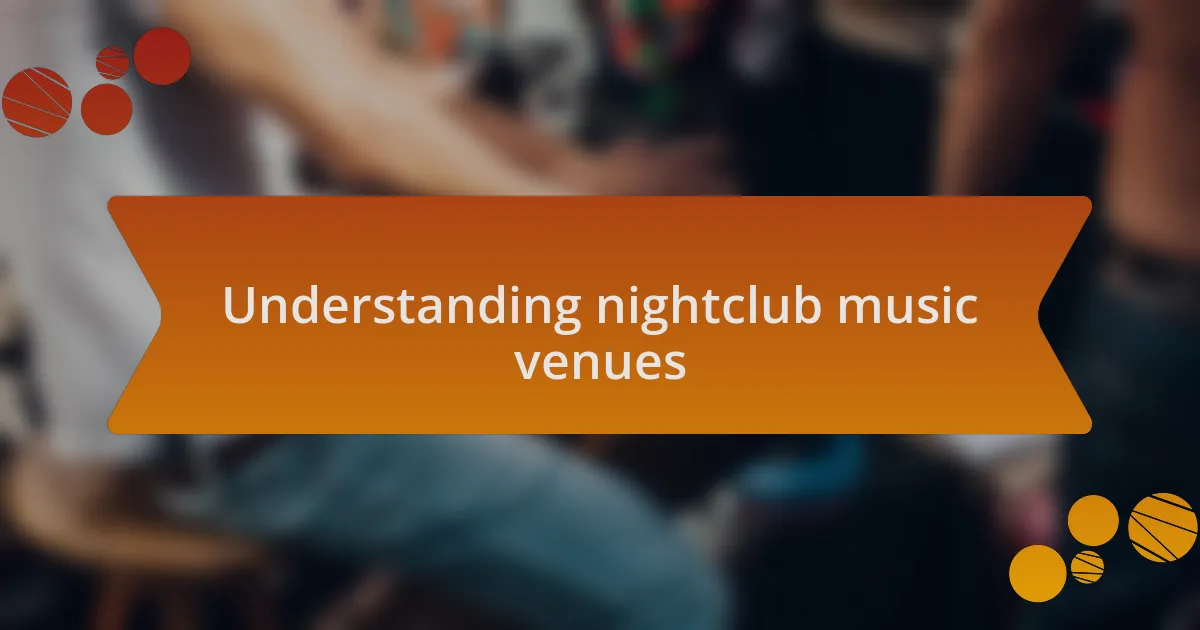
Understanding nightclub music venues
Nightclub music venues are unique spaces where energy flows between performers and the audience, creating unforgettable experiences. I remember the first time I stepped into a vibrant nightclub; the pulsating beats felt like a heartbeat syncing with my own. This intimate connection is what makes these venues special—they become a haven for self-expression and a retreat from the mundane.
The design and atmosphere of a nightclub play a crucial role in shaping the music experience. Think about it: dim lighting, flickering strobe lights, and that thick bass that reverberates through your chest. Each element combines to create an immersive environment where music is not just heard but felt. It sparks emotions and connections, sometimes leading to spontaneous friendships or even romances on the dance floor.
I often ponder the diverse music genres represented in these venues. Have you ever noticed how one night might be all about house music while another showcases local hip-hop artists? This changing dynamic keeps the scene fresh and exciting, as artists constantly adapt and experiment. For me, it’s this ever-evolving nature of nightclub music that keeps me coming back for more, never quite knowing what to expect next.
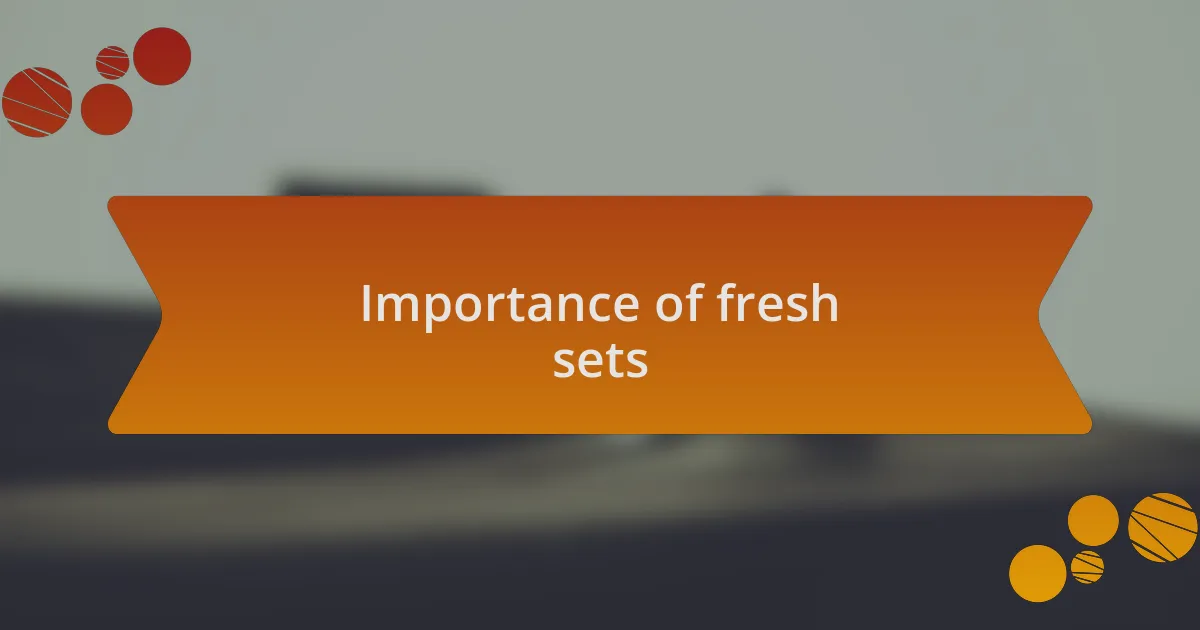
Importance of fresh sets
The importance of fresh sets in a nightclub isn’t just about the music; it’s about the vibe and connection with the crowd. I recall attending a local DJ’s set where he dropped a remix that I’d never heard before. The way the crowd erupted, lost in the moment, underscored how crucial fresh content is. It creates an electric atmosphere, allowing patrons to experience something new with each visit, keeping them eager for more.
When a DJ spins the same tracks over and over, it’s easy for the excitement to fade. I’ve felt that lull; you wander off to the bar or step outside for a breather, waiting for that one track to spark life back into the room. Fresh sets fuel anticipation, making each night feel unique. It’s not just about familiarity; it’s about the thrill of discovering that next favorite song in the mix.
Importantly, fresh sets can define a venue’s identity in a crowded market. Have you ever noticed how certain clubs build a reputation around showcasing emerging artists? I’ve found visiting these spots feels like an adventure, where the line-up is a journey through uncharted musical waters. This strategy doesn’t just attract new talent; it cultivates a loyal community of music lovers who thrive on that sense of discovery.
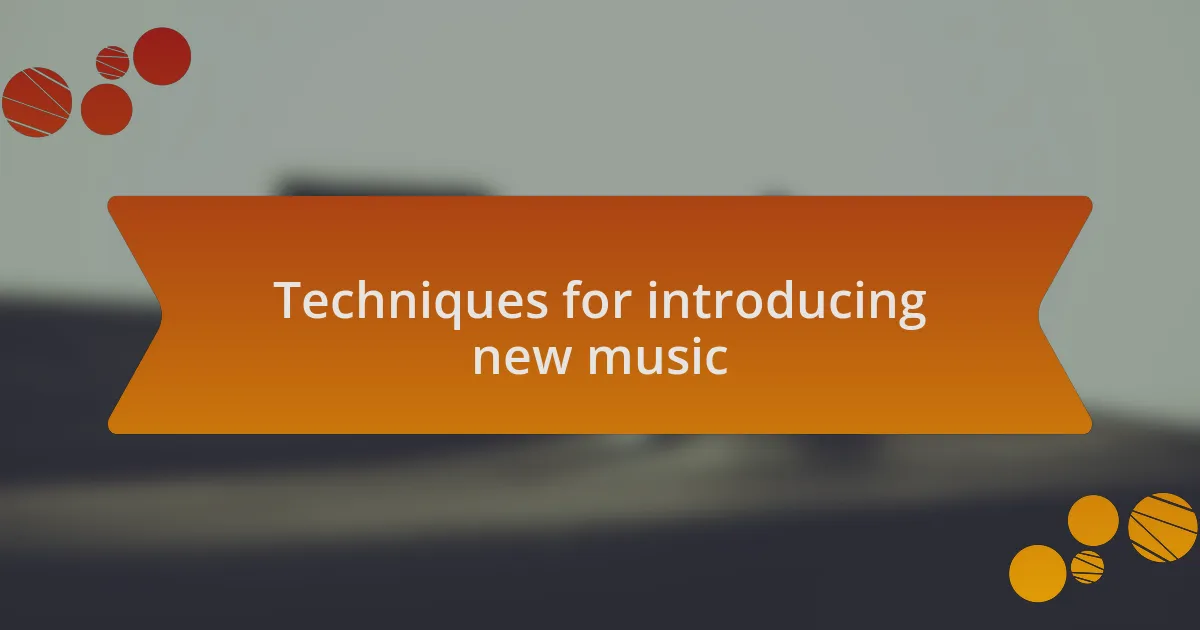
Techniques for introducing new music
When introducing new music, one effective technique is to incorporate local and underground talent into the mix. Personally, I’ve found that when I feature an up-and-coming DJ in my set, it creates an exhilarating sense of discovery. There’s a unique energy in watching the crowd react to fresh sounds they’ve never encountered before, which often leads to spontaneous moments of pure joy on the dance floor.
I also love to softly blend in newer tracks with familiar ones. By using techniques like beat-matching or layering, I gently introduce something unexpected without losing the crowd’s connection. For instance, I remember a night when I dropped a recent release right after a classic hit; the way people responded was electric! Their surprise quickly turned into excitement, and it transformed the energy in the room.
Another approach is to curate themed nights around specific genres or trends, focusing on new music within that space. I once did a “Future Sounds” night, dedicated to showcasing the latest in electronic music. It was thrilling to see regulars come in, expecting to dance to their favorites, only to be delighted by the new wave of artists I introduced. This not only keeps the sets fresh but also encourages conversations among patrons about the music, enhancing their experience and connection to the venue.
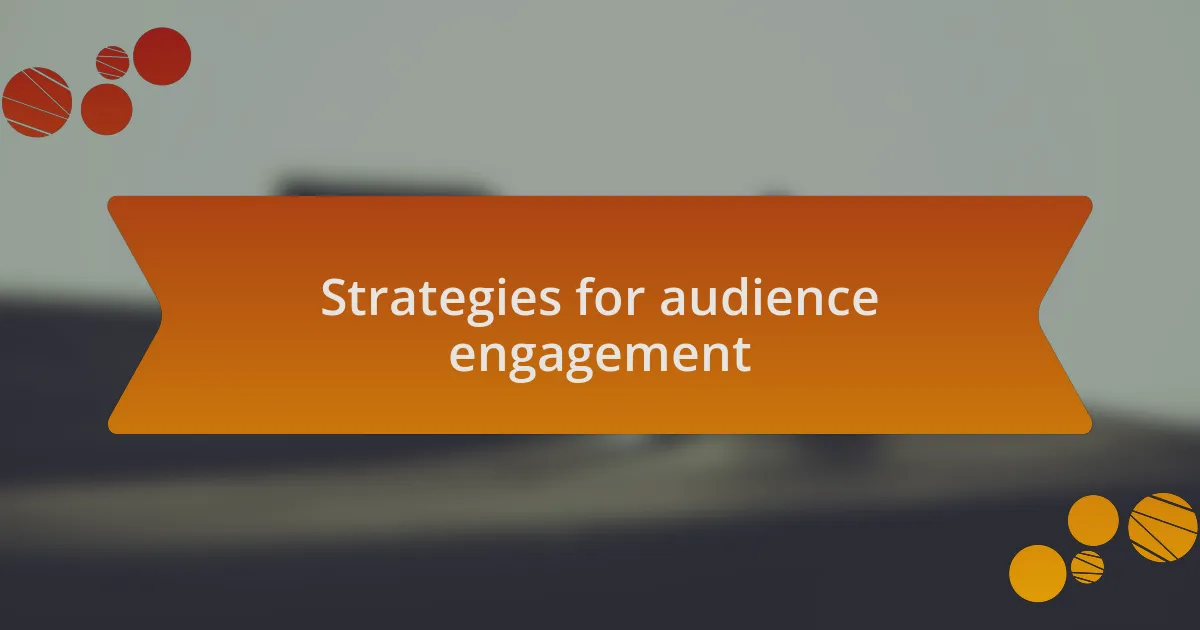
Strategies for audience engagement
Engaging the audience goes beyond just spinning tracks; it’s about creating a communal atmosphere. One of my favorite strategies is using call-and-response techniques during peak moments. Picture this: I’ll get the crowd to sing along or repeat a catchy phrase from a popular track. The energy is contagious, and I get such a thrill from hearing hundreds of voices unify in the moment. Have you ever experienced that feeling? It transforms the dance floor into a lively conversation and leaves a lasting memory.
Another strategy that I find incredibly impactful is incorporating live elements into my sets. I’ve invited musicians to jam along with me, blending real-time improvisation with the beats. There was a night where a saxophonist joined me unexpectedly, and the interplay between the sax and the electronic sounds was electrifying. People responded with pure enthusiasm, rushing to the front to immerse themselves in that live aspect of the performance. It’s those moments of spontaneity that can set the night apart and create a deeper connection with the crowd.
Lastly, I often encourage social media interaction by creating hashtags that patrons can use during the event. After all, who doesn’t love the chance to be part of a larger narrative? I remember one event where I urged everyone to post their highlights with a specific hashtag, which led to an outpouring of photos and stories that continued the nightlife conversation long after the party ended. This not only engages them during the night but also invites them to share their experience, fostering a sense of community and anticipation for future events.

Personal experiences with set changes
When I think about set changes, I immediately recall a night where I was deeply engrossed in a progressive house set. I decided to shift gears and dropped a classic 90s track. The instant reaction was electric. People turned toward each other, sharing smiles and shouts of recognition. It felt as if I had unified a generation in that split second – doesn’t that just send chills down your spine?
One time, I experimented with an unexpected tempo change during the peak of my set. The dance floor temporarily froze, faces bewildered. Then, as the new rhythm settled in, it felt like a floodgate opened. Suddenly, everyone was back to life, and their joyous abandon made the moment unforgettable. Who would have thought that a mere change in pace could provoke such a visceral response?
I also remember a night when I mixed an instrumental piece into an otherwise vocal-heavy set. At first, I worried about losing the crowd, but instead, I watched as they closed their eyes, swaying and soaking in the soundscape. Those moments remind me that sometimes, a change in the atmosphere can lead to unexpected intimacy on the dance floor. Have you ever felt that beautiful shift where music connects us on a deeper level? It’s what keeps me inspired each time I step behind the decks.
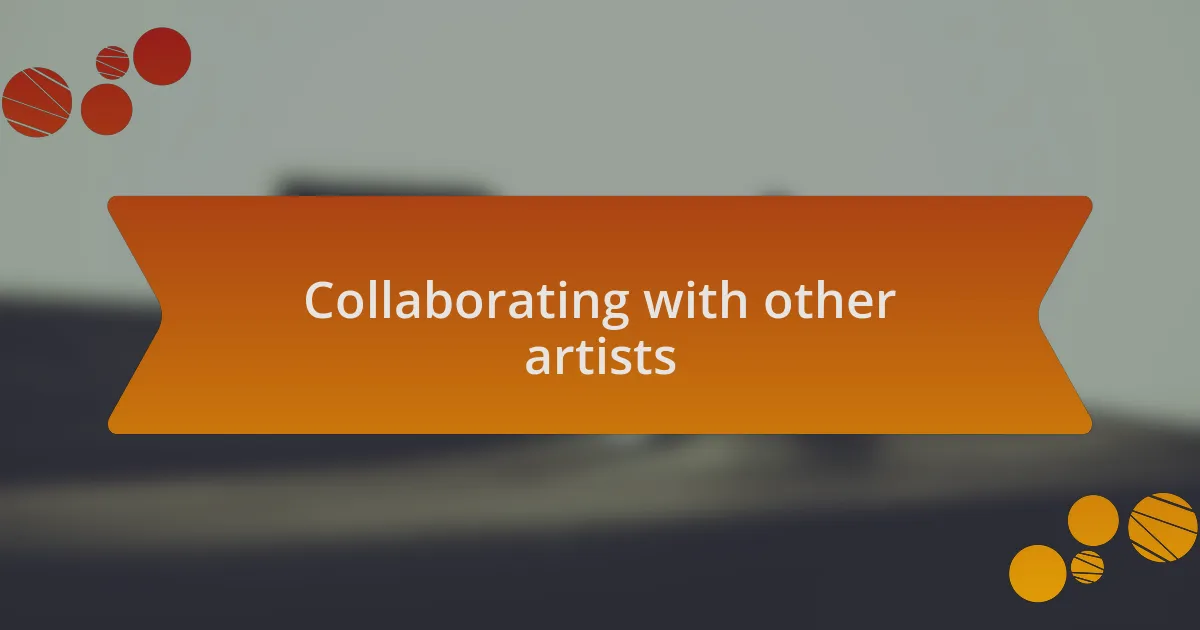
Collaborating with other artists
Collaborating with other artists has been one of the most rewarding experiences in my DJ journey. I recall a night when I teamed up with a live percussionist, and it transformed the whole vibe of the set. The synergy between the beats and drums created an organic energy that was simply captivating. Have you ever felt that moment when the music just flows effortlessly? It was like we had tapped into a collective heartbeat of the crowd.
Another memorable collaboration was with a vocalist during an outdoor festival. Our styles were different, yet we managed to find a common musical thread. As she belted out soulful melodies over my deep house beats, I could see the audience connect in real-time, swaying together under the stars. Isn’t it incredible how music can transcend genres and unite people? That night, I learned that collaboration isn’t just about merging sounds; it’s about crafting an experience that resonates with everyone present.
I’ve also found that collaborating opens doors to new ideas and techniques. One producer I worked with had a knack for incorporating electronic elements in ways I hadn’t considered before. By experimenting together, we discovered innovative sounds that left our fans buzzing with excitement. Isn’t it amazing how sharing creative space can birth something entirely unexpected? Each partnership challenges me to push my boundaries, reminding me that the journey of music is best traveled together.
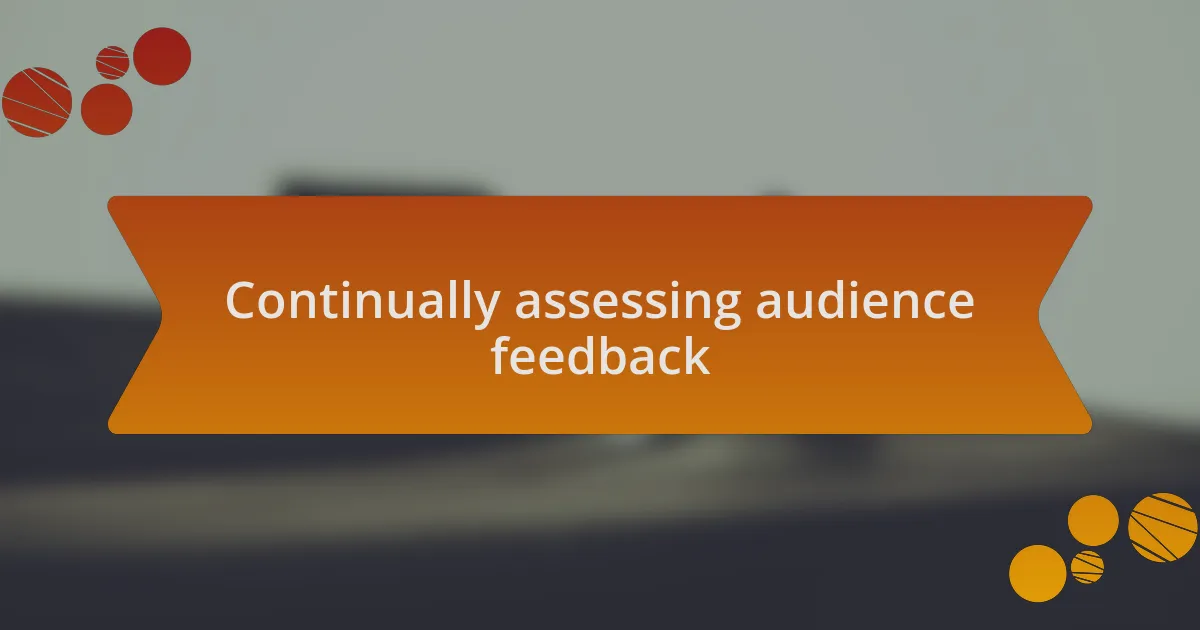
Continually assessing audience feedback
Continually assessing audience feedback is essential in keeping my sets fresh and vibrant. I recall a night when I tried a new track that fell flat with the crowd—there was an unmistakable shift in energy. Seeing the audience’s lack of engagement pushed me to pivot quickly, seamlessly transitioning to a track that amplified the excitement. It’s in these moments that I truly appreciate the power of real-time feedback.
In another instance, I noticed that specific beats resonated deeply one evening, sparking spontaneous dancing among the crowd. It was exhilarating to witness! This inspired me to weave those elements into my upcoming sets. I often ask myself, how can I capture that same magic and elevate it for the next show? By staying in tune with the audience’s reactions, I can adapt on the fly and craft an unforgettable experience.
Moreover, I engage with my listeners on social media after performances. When fans share what they loved or suggest tracks they want to hear, it creates a community dialogue. I remember receiving a message from a fan who appreciated a deep cut I played; that moment not only validated my choices but also encouraged me to dig deeper into my catalog for future sets. It’s all about creating connections and evolving based on shared experiences, don’t you think?